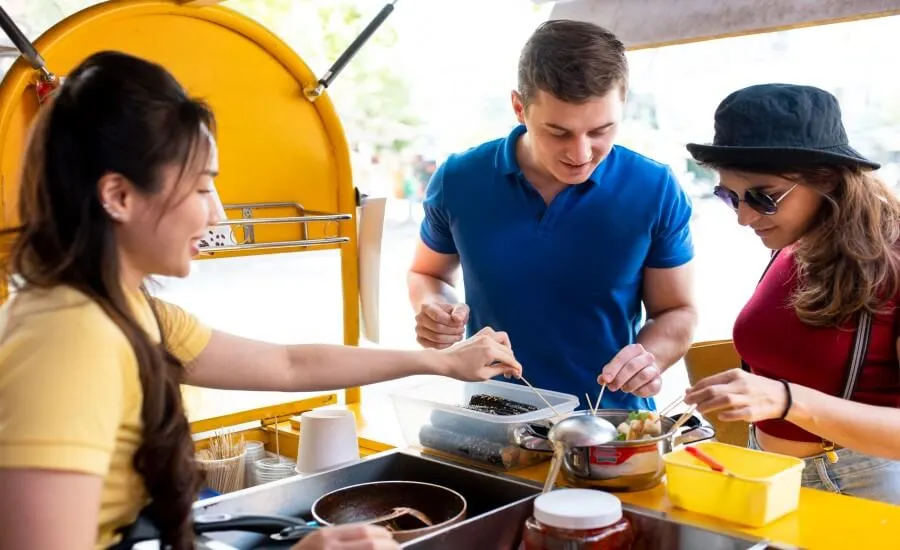
Think back to your most cherished travel memories. Chances are, many of them revolve around food. Perhaps it was that unforgettable plate of street food discovered down a bustling alleyway, a hilarious attempt at ordering in a foreign language that led to laughter with the vendor, or a shared meal with newfound friends where conversation flowed as freely as the local wine. Food is far more than mere sustenance when we travel; it’s a language, a history lesson, a cultural key and a powerful catalyst for connection.
In our fast-paced world, where experiences can sometimes feel superficial, culinary travel offers a delicious pathway to deeper understanding and more meaningful bonds. It invites us to slow down, engage our senses, and connect authentically with a place and its people through the universal experience of sharing a meal. This post explores culinary travel reconnection – how exploring local food can forge stronger links with destinations, cultures, fellow travelers, and even ourselves, transforming a simple trip into a richer, more resonant journey.
More Than Just a Meal: The Power of Food in Travel

Food is inextricably woven into the fabric of culture. It tells stories of geography, climate, history, migration, religion, and social customs. What grows locally, how ingredients are prepared, who cooks what dishes, when and how meals are eaten – all these elements offer profound insights into a region’s identity and way of life. Exploring local cuisine is like opening a living history book, one that engages all your senses.
Consider the importance of rice across Southeast Asia, reflecting its agricultural landscape. Think of the diverse spices in Indian cuisine, hinting at centuries of trade and cultural exchange – the very spices that influenced global history. Or contemplate the simple, seasonal ingredients used in traditional Italian cooking, speaking to a deep connection with the land. Here in Gujarat, the prevalence of vegetarian dishes tells a story of Jain and Hindu influences, while the unique blend of sweet, salty, and spicy flavors in dishes like a classic Gujarati Thali reflects a distinct regional palate.
Beyond history and geography, food is fundamentally social. Across cultures, meals are focal points for connection, celebration, and community. From family dinners to festive banquets (like those during Uttarayan or Diwali in Gujarat), sharing food binds people together. When we travel and engage with local food culture – whether sharing a table at a bustling Vadodara eatery enjoying Sev Usal, learning a recipe from a local, or simply observing market interactions – we tap into this universal social dimension, creating opportunities for authentic human connection that often transcend language barriers. Food becomes the bridge.
Tasting the Culture: How Local Food Builds Deeper Bonds

Culinary travel reconnection happens through multiple pathways, transforming eating from a biological necessity into a powerful tool for building bridges and understanding.
- Breaking Bread, Breaking Barriers: Sharing a meal is one of the most fundamental ways humans connect. Sitting down to eat local food, whether in a simple eatery, a family home (if you’re lucky!), or even sampling street food alongside locals, creates an immediate sense of shared experience and common ground. It fosters conversation and dissolves the ‘us vs. them’ mentality.
- Understanding History & Place: Local dishes are edible archives. Trying Undhiyu in Gujarat during winter connects you to seasonal farming practices. Learning about the spices in a Goan vindaloo reveals Portuguese colonial history. Understanding why certain ingredients are used tells stories of climate, trade routes, and resourcefulness. This contextual knowledge creates a much deeper bond with the destination.
- Engaging with Local Communities: Seeking out authentic food experiences inevitably leads you to interact more with local people – market vendors, street food sellers, restaurant owners, home cooks. These interactions, even brief ones, provide genuine glimpses into local life and support local economies directly, fostering a more responsible and connected form of tourism.
- Shared Vulnerability & Trust: Trying unfamiliar food requires a degree of openness and vulnerability. When locals see you genuinely appreciating their cuisine, it often builds trust and warmth, leading to more meaningful exchanges. Offering food is a universal gesture of hospitality; accepting it graciously builds rapport.
- Connecting with Travel Companions: Sharing the adventure of discovering new flavors, navigating unfamiliar menus, and reacting to different tastes creates strong bonds between travel partners. These shared culinary experiences become cherished memories long after the trip ends.
Through these mechanisms, food moves beyond mere taste to become a vehicle for empathy, understanding, and genuine human connection.
Mindful Munching: Engaging Your Senses for Richer Food Experiences

To truly connect through culinary travel, engage not just your taste buds, but your full awareness. Mindful eating transforms the act of consumption into a rich sensory experience, deepening your appreciation and connection to the food and its context.
- Slow Down: Resist the urge to rush through meals. Put down your fork between bites. Take time to truly savor the experience, especially when trying something new or unique to the region.
- Engage All Senses: Before tasting, take a moment.
- Look: Notice the colors, shapes, arrangement on the plate. Appreciate the visual presentation.
- Smell: Inhale the aromas. What scents can you identify? Spices, herbs, cooking methods (grilling, frying)?
- Touch: Notice the temperature and texture of the food in your mouth (or with your hands, if culturally appropriate). Is it smooth, crunchy, soft, chewy?
- Taste: Identify the primary tastes – sweet, sour, salty, bitter, umami. Notice how flavors evolve and combine.
- Listen: Pay attention to the sounds of eating – the crunch, the sizzle (if fresh off the stove), even the sounds of the dining environment.
- Appreciate the Ingredients & Preparation: Consider where the ingredients might have come from (local market? nearby farm?). Appreciate the skill and effort involved in preparing the dish, especially if it’s complex like a traditional Gujarati Thali with its many components.
- Eat Without Distraction: Put away your phone. Minimize conversation briefly while truly focusing on the first few bites of something new. Be present with the food and the act of eating.
- Notice Your Body’s Response: Pay attention to hunger and fullness cues. Eat until satisfied, not stuffed. Notice how the food makes you feel – energized, comforted, perhaps challenged by a new spice level!
Practicing mindful eating while traveling doesn’t mean every meal needs to be a silent meditation, but incorporating moments of focused sensory awareness greatly enhances the culinary connection.
Beyond Restaurants: Finding Authentic Culinary Connections

While restaurants offer wonderful experiences, truly authentic culinary connections often happen beyond formal dining rooms. Here’s how to dive deeper:
- Hit the Streets: Street food is the pulse of many cultures. It’s often delicious, cheap, and cooked right before your eyes. Look for busy stalls popular with locals (a good sign of quality and safety). In Vadodara, this might mean seeking out renowned Sev Usal stalls or trying Dabeli from a trusted vendor.
- Explore Local Markets: Markets are sensory feasts and cultural hubs. See fresh produce, discover unfamiliar ingredients, watch vendors interact, and often find stalls selling ready-to-eat snacks or simple meals. It’s a fantastic place to learn and observe.
- Take a Cooking Class: A hands-on way to learn about local ingredients, techniques, and recipes directly from local cooks. Many classes include market tours and end with a shared meal you helped prepare.
- Join a Food Tour: Let a knowledgeable local guide lead you to hidden culinary gems, explain dishes, and share cultural context. Tours might focus on street food, specific neighborhoods, or types of cuisine (like a ‘Farsan’ tour in Gujarat).
- Consider Homestays or Meal-Sharing Experiences: Platforms sometimes connect travelers with local families for home-cooked meals. This offers unparalleled insight into local life and food traditions, though requires research and respect.
- Visit Local ‘Specialty’ Shops: Don’t just eat meals out; explore local bakeries, sweet shops (mithaiwalas), or shops specializing in regional snacks (like Vadodara’s farsan shops selling items like bhakharwadi or khandvi).
Stepping slightly off the main restaurant path often leads to the most memorable and authentic food discoveries.
Culinary Travel on Any Budget: Making it Accessible

Culinary exploration doesn’t have to be expensive! You can experience the authentic flavors of a destination without needing reservations at Michelin-starred restaurants.
- Embrace Street Food & Markets: As mentioned, these are usually the most budget-friendly ways to sample a wide variety of local dishes and snacks. A full, delicious meal can often be had for just a few dollars (or equivalent rupees).
- Seek Out Local Eateries: Look for simple, family-run restaurants, canteens, or ‘dhabas’ (in India) away from the main tourist drags. These places often serve hearty, authentic food at much lower prices. Ask hostel staff or local workers for recommendations.
- Lunch Specials: In many countries, restaurants offer significantly cheaper set menus (‘plate of the day’, ‘menu del dia’) at lunchtime compared to dinner. Make lunch your main meal out.
- Picnics & Self-Catering: Visit local markets or grocery stores for fresh bread, cheese, fruit, local pastries, or other simple items. Enjoying a picnic in a park or scenic spot is both affordable and enjoyable. If staying in hostels or apartments with kitchens, cooking simple meals using local ingredients is a great way to save.
- Focus on Staples: Rice, noodles, bread, pulses, and seasonal vegetables often form the affordable base of local diets. Explore dishes centered around these staples.
- Limit Expensive Drinks: Alcohol, imported sodas, and fancy coffees can quickly inflate your food budget. Stick to water (carry a reusable bottle and check potability, or buy large jugs), local tea, or simple local beverages.
Delicious and authentic food experiences are available at every price point if you know where and how to look.
Common Concerns & Solutions

Venturing into unfamiliar culinary territory can sometimes feel daunting. Here’s how to handle common concerns:
- Concern: “Is street food safe to eat?”
- Solution: Often, yes, if you choose wisely! Follow the tips: pick busy stalls popular with locals, observe hygiene practices, opt for food cooked fresh and hot, avoid raw/undercooked items and questionable water/ice. Start slow to let your system adjust. Trust your senses – if it looks or smells off, skip it. Carry hand sanitizer. (See previous search results for more detailed tips).
- Concern: “I have dietary restrictions (vegetarian, allergies, etc.).”
- Solution: Research common ingredients and dishes beforehand. Learn key phrases in the local language to explain your restrictions (e.g., “No meat,” “allergic to nuts”). Translation apps are helpful. Carry translated cards explaining your needs clearly. Be extra cautious with street food if allergies are severe; restaurants often offer more control. In vegetarian-friendly regions like Gujarat, finding options is easy, but always clarify ingredients if unsure.
- Concern: “I don’t speak the language – how will I order?”
- Solution: Learn basic food-related phrases (“How much?”, “Water,” “Delicious!”). Pointing at dishes (if visible) or pictures on a menu works well. Use translation apps. Observe what locals are eating. Be patient and polite – a smile goes a long way! Often vendors are happy to help.
- Concern: “How do I find truly authentic places, not just tourist traps?”
- Solution: Venture away from main tourist squares (use the ‘Five Block Rule’). Look for places filled with locals. Ask for recommendations from non-tourist industry locals (e.g., shopkeepers, students). Check local food blogs or review sites (but be discerning). Trust your gut – does it feel like a place locals frequent?
Mindful Culinary Explorer Checklist

Prepare yourself for a delicious journey of connection:
- Research Local Cuisine: Identify must-try dishes, regional specialties, seasonal ingredients, and mealtime customs before you go.
- Learn Basic Food Phrases: “Hello,” “Thank You,” “How much?”, “Delicious,” plus terms for your dietary needs if applicable.
- Pack Reusable Essentials: Water bottle, maybe a reusable container/cutlery set (great for markets/takeaway, reduces waste).
- Carry Hand Sanitizer & Basic Meds: For personal hygiene and minor stomach upsets (just in case).
- Download Offline Maps & Translation Apps: For navigation and communication.
- Bring an Open Mind & Adventurous Palate: Be willing to try new things!
- Set an Intention: Aim to connect, learn, and savor, not just consume.
Conclusion: Connecting the World, One Bite at a Time

Food is a thread that weaves through the tapestry of human experience, connecting us to place, culture, history, and each other in profound ways. Culinary travel, approached with mindfulness and curiosity, transforms meals from simple refueling stops into opportunities for deep connection and understanding. It encourages us to slow down, engage our senses, step outside our comfort zones, and appreciate the rich diversity of the world through its flavors.
Whether you’re savoring street-side Sev Usal in Vadodara, sharing tapas in Spain, learning to make pho in Vietnam, or simply exploring the offerings at your local farmers market with fresh eyes, prioritize the culinary journey. Let your taste buds lead you to deeper bonds, richer memories, and a more flavorful understanding of the world and your place within it.
On your next trip, make a conscious effort to explore the local food scene beyond the obvious. Ask questions, be adventurous, eat mindfully, and taste the connection.






